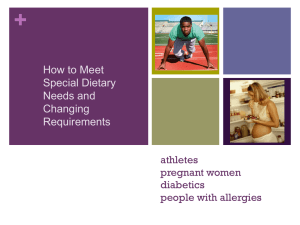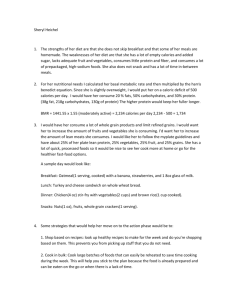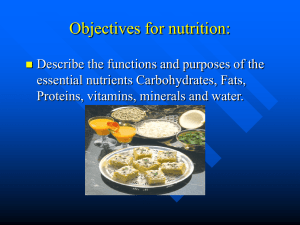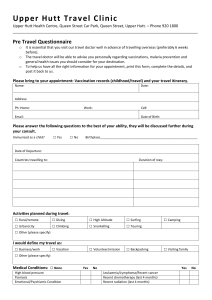Nutrition PPT
advertisement
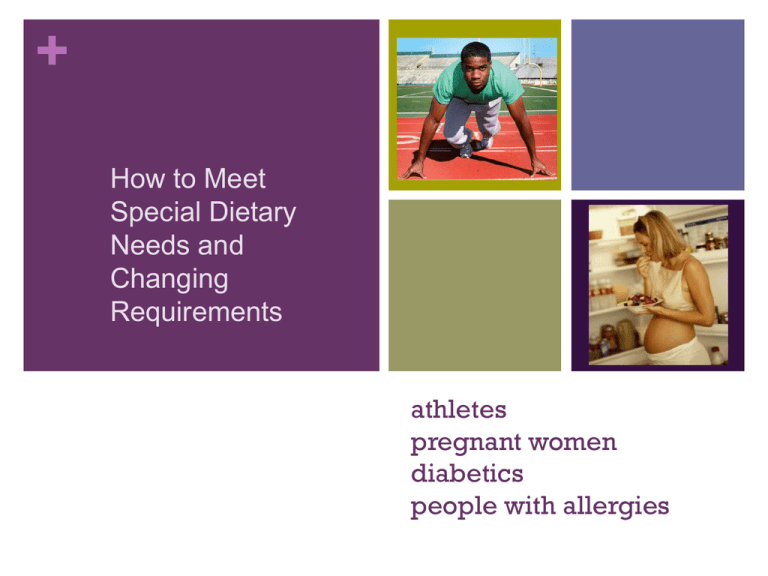
+ How to Meet Special Dietary Needs and Changing Requirements athletes pregnant women diabetics people with allergies + What are special needs and changing requirements? Some examples include: Food allergies Sports nutrition Pregnancy Diabetes Goal to gain, lose, or maintain a healthy weight + Food Allergies A food allergy: abnormal response to a food, triggered by the body’s immune system. Reactions to food can range from mild to life-threatening. Food allergies generally develop early in life but can develop at any age. What Foods Most Commonly Cause Allergic Reactions? + 8 Major Food Allergens Milk Soy Eggs Wheat Peanuts Fish Tree Shellfish nuts Most children eventually outgrow milk, egg, soy, and wheat allergy. If someone has food allergy, he or she is more likely to have asthma or eczema. + Myth or Fact? Food allergies are uncommon. + Answer: Myth As many as 15 million people in the U.S. have food allergies, including approximately 6 million children. + SYMPTOMS If you are allergic to a particular food, you may experience some or all of the following symptoms: Itching in your mouth or swelling GI symptoms, such as vomiting, diarrhea, or abdominal cramps and pain Hives or eczema Tightening Drop of the throat and trouble breathing in blood pressure + Planning Meals for Individuals With Food Allergies Because food allergies can be life threatening, the allergy-producing food must be completely avoided. The FDA requires that ingredients are listed on food labels. Look at the label listings to determine the presence of any allergens. Most life-threatening allergic reactions occur when eating occurs away from home. It is important to plan to eat at a restaurant which caters to special dietary requests. + Sports Nutrition Good nutrition is a critical component of a sports training or physical activity program. There is no “miracle food or supplement” which can supply all of your nutritional needs. What you eat can have a big effect on how you perform. + Myth or Fact? The more protein you eat, the more muscle you’ll gain. + Myth Muscle tissue is made up of protein, and athletes do need a bit more protein than non-athletes, but the fact is that the vast majority of athletes meet their daily protein needs without even really trying. Extra protein beyond what's needed is just extra calories. Leaner sources of protein with other food groups is recommended. + What Is the Best Diet for Athletes? All athletes need a diet which provides energy in the form of carbohydrates and fat as well as essential protein, vitamins, and minerals. 55-60% of calories should come from carbohydrates. (Carbohydrates are the base of the diet in the form of starches and sugars.) No more than 30% of calories should come from fat. 10-15% of calories should come from protein. + Do athletes need to carb load? Carbohydrate loading is a special technique of eating large amounts of carbohydrates for several days before an endurance (long distance) event. Most athletes do not need to carb load but instead should focus on getting enough carbohydrates every day from a variety of sources. Carbohydrates are stored as glycogen in the liver and muscles. There is usually enough glycogen in muscles from a balanced diet to provide fuel for 90-120 minutes of exercise. + Water – A Key Component in a Healthy Diet for Athletes Water helps to regulate body temperature and keeps the body from overheating during exercise. Losing just 2% of the body’s water can hurt performance. Water is essential in transporting nutrients and energy to the muscles and tissues used during exercise. Water is also important in transporting waste products away from the muscles and tissues after muscle exertion. + Myth or Fact? It is best to compete in athletic events on an empty stomach. + A Pre-Game Meal Consumed 3-4 Hours Before Activity is Optimal to Fuel Working Muscles Most research recommends pre-game meals which provide 500-1,000 calories. The meal should be high in starch, which breaks down more easily than protein and fats. The starch should be in the form of complex carbohydrates (breads, cold cereals, pasta, fruit, and vegetables). These are digested at a rate which provides consistent energy to the body. + A Pre-Game Meal Consumed 3-4 Hours Before Activity is Optimal to Fuel Working Muscles Avoid meals high in fat as it takes longer to digest. Take in adequate fluids. Avoid caffeine which can lead to dehydration by increasing urination. For protein – Take in small amounts of lean meat, legumes, dried beans, or eggs. These are just a few examples. Make wise choices baked or broiled vs. fried. + Nutrition after Exercise Post exercise is the optimal time to increase glycogen stores. No matter how intense the exercise, it is important to drink plenty of water and eat a balanced meal which has adequate amounts of carbohydrate-rich foods such as grains, pasta, vegetables, and fruits. What Nutrients Might a Pregnant Woman Need More Than a NonPregnant Woman? + Increased Nutrient Needs for Pregnant Women Calcium Vitamin Folic Carbohydrate Acid D Calories Fiber Iron Vitamins Minerals and + Nutritional Changes for Pregnant Women A pregnant woman needs about 300 calories a day more than she did prepregnancy to support the rapid growth of the fetus and her changing body. The expectant mother will need increased amounts of protein (75 grams/day or 25 more than nonpregnant women). Good sources of protein are lean meats, poultry, fish, dried beans, lentils, nuts, eggs, and cheese, which provide protein and also supply other nutrients such as iron, B vitamins, and trace minerals. + Calcium Recommendations for Pregnant Women The calcium recommendation during pregnancy is 1,000 mg/day for women ages 19-50 and 1,300 for teens. Women who are not pregnant usually only consume 75% of the daily requirement. Therefore, most pregnant women need to add calcium-rich foods to their diets. Milk, yogurt, ice milk, frozen yogurt, green leafy vegetables, and calcium-fortified foods such as orange juice, soy milk, bread, and breakfast cereal are good sources of calcium. Calcium supplements are advised for women who do not meet their calcium needs through food alone. Because vitamin D is important in the absorption and utilization of calcium, vitamin D intake should also be monitored. + Pregnant Women – Nutrition Needs Additional iron is needed because of the increased amount of blood volume during pregnancy (27 mg/day – 9 more grams than pre-pregnancy). Enriched whole grain breads, cereals, green leafy vegetables, legumes, eggs, and dried fruits provide iron. + Folic Acid for Pregnant Women Folic acid plays a vital role in cell development and in the formation of certain major structures of the fetus. Because of its importance, all women of childbearing age need adequate intake of folic acid. Research suggests that taking folic acid before and during pregnancy can reduce the risk of neural tube defects (such as spina bifida) in infants. + Folic Acid for Pregnant Women The March of Dimes recommends that all women who can become pregnant consume a multivitamin containing 400 micrograms of folic acid daily. (Most women do not consume adequate amounts in their diets). Good sources of folate include green leafy vegetables, legumes, citrus fruits and juices, peanuts, and some fortified breakfast cereals. + Myth or Fact? People with diabetes cannot have foods containing sugar, such as candy and desserts. + Myth Current research studies have shown that old beliefs about sugar and diabetes may have been incorrect. Numerous studies now show that candy and sweets do not elevate blood sugar levels any higher or any more quickly than certain starches such as white bread, white rice, or white potatoes. People with diabetes can have starches, sugars, and sweets as long as they make sure they are eaten in moderation and are part of a balanced diet. A dietitian can help determine how much and when to include these foods into a meal plan. + Nutrition Tips for People with Diabetes No single plan will work for all people, the following are general tips. Follow a consistent meal plan and schedule. Eat a balanced diet with a variety of foods including fruits, vegetables, whole grain foods, low-fat dairy products, lean meat, poultry, fish or meat alternatives. This will help keep the blood sugar levels steady. Choose lower fat options and limit saturated fats. + Nutrition Tips for People with Diabetes No single plan will work for all people. The following are general tips. Check nutrition labels. Use sugar in moderation or sugar substitutes. Consider lower sugar options if available. Get plenty of fiber in the diet. The American Dietetic Association recommends that all people eat 20-35 grams of fiber per day. Fruits, vegetables, beans and whole grain foods are good sources of fiber. Drink Use plenty of water. less salt. + Myth or Fact? An eating plan which offers weight reduction of over eight pounds in the first week is a good plan. This gives your metabolism a kick start. + Myth Healthy weight loss is usually no more than two pounds per week. With the correct combination of physical activity and proper nutrition, this type of weight loss can stay off as opposed to temporary dramatic losses due to extremely low caloric intake which decrease water weight and is not sustainable. + Losing Weight and Gaining Weight Healthy weight loss or gain should be no more or less than two pounds per week. The amount of intake (calories consumed) and the amount of output (calories expended) have a direct relationship with weight gain or loss. Set meal plans which follow the Dietary Guidelines for Americans and MyPlate based on goals of weight loss, weight gain, or healthy weight maintenance. + Weight Loss Determine an appropriate calorie total for intake based on output or expenditure with exercise and daily physical activity. Plan meals which are balanced (60% carbohydrate, less than 30% fat, 10-15% protein) and allow for a variety of nutrients. Limit the amount of saturated fat and LDL cholesterol in the meals selected. + Weight Gain Determine an appropriate calorie total for intake based on output or expenditure with exercise and daily physical activity. Plan meals that are balanced (60% carbohydrate, less than 30% fat, 10-15% protein) and allow for a variety of nutrients. Try to increase the amount of caloric intake from food sources such as fruits, vegetables, and complex carbohydrates.
